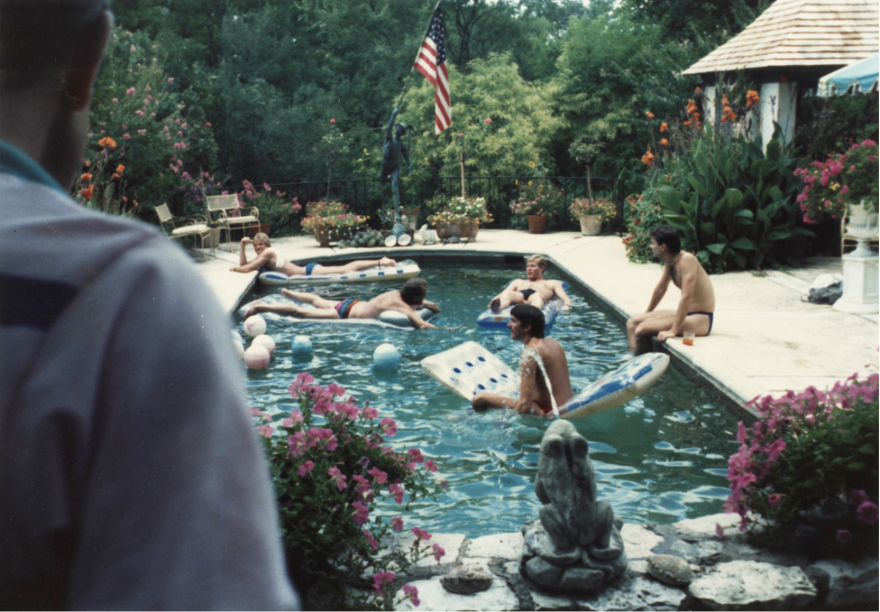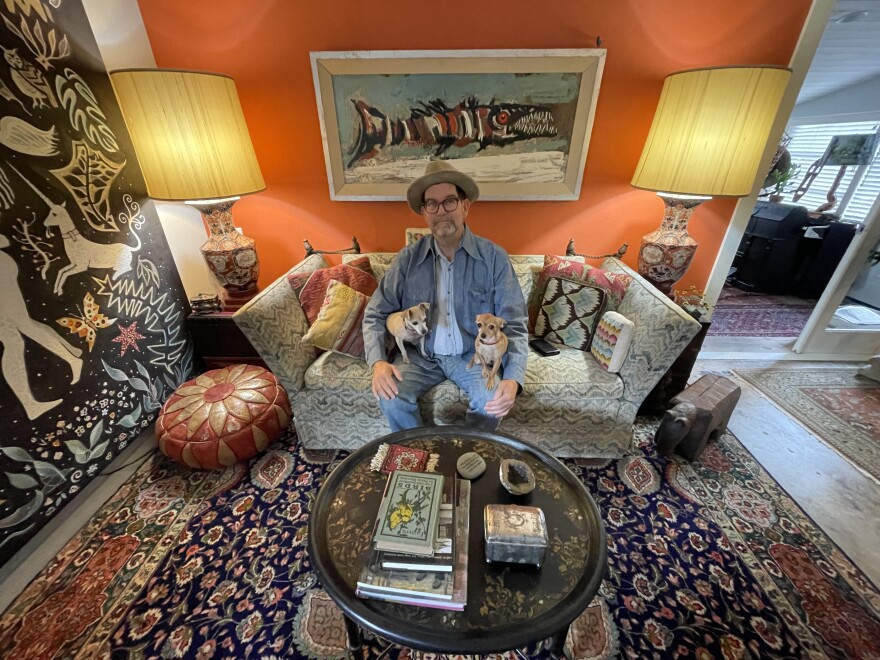Gaby Fuentes was walking to a concert at the Frank Erwin Center a few years ago when she noticed something she’d never seen before. Tucked behind an old wooden gate and shrouded by overgrown trees was an abandoned house overlooking Waller Creek.
She couldn’t see most of it, just a French-style mansard roof emerging from the foliage. But she could tell it was once something beautiful.
“It must have been an amazing house,” Fuentes said.
She had been walking near the corner of 18th Street and Red River, within UT’s medical district. Once she spotted the hidden home, she was struck by how out of place it seemed, surrounded by modern, multistory buildings, like Dell Medical School. She was also surprised she’d never noticed it before.
“I had walked by there so many times and driven down Red River so many times,” said Fuentes, who has lived in Austin for 40 years. “My mind was blown when I finally saw it.”
Questions began swirling in her mind.
“How old is this house?” she wondered. “Who lived here?”
So, she asked KUT’s ATXplained project.
‘The Watson Chateau’
The home is one of Austin’s oldest buildings, dating back to 1853. The UT Austin website calls the property the Arthur P. Watson House, after one of the last residents to live there.
But researcher Marta Stefaniuk calls it the Watson Chateau. That’s because in the home’s heyday, it was known colloquially as “The Chateau.”
Watson bought the home in 1959 and lived there with his partner, Robert Garrett, for more than 30 years. Watson and Garrett, two well-known interior designers, hosted legendary parties in the three-story home, which was decorated with unique finds from their world travels. In the backyard, there was a pool, tiered gardens and a greenhouse.
“They loved beauty,” Stefaniuk said. “They liked things to be aesthetically pleasing and worked hard to keep it that way. Just everything was immaculate and fascinating and gorgeous.”

The guest list often included Austin’s elite. The Chateau’s location near the Frank Erwin Center, which opened in 1977, also meant the parties featured the occasional out-of-town celebrity. Opera star Luciano Pavarotti is said to have visited the Chateau, and one time — so the story goes — actor Rock Hudson took refuge at the home to avoid crazed crowds after a football game, Stefaniuk said.
“They loved having people over,” she said. “Almost every day something was happening. They were hosting someone. They were basically like cultural ambassadors of Austin.”
Stefaniuk has been researching the Watson Chateau since 2020, when she stumbled upon it while on a bike ride. Last year, the city published her research in an online exhibit.
Like Fuentes, Stefaniuk was intrigued by the mystery. There were no signs telling her what the house was. As she began doing research, she came to realize the home’s hidden nature was once a benefit.
Watson and Garrett were gay in a time when being out wasn’t socially accepted or safe. The parties they hosted were places where gay men in Austin could be themselves.
“Neither of them were allowed to live a life open,” Stefaniuk said. “And that was part of both the advantage and disadvantage of the house location. It was in the middle of everything, but it was also secluded enough and small enough where you couldn't quite tell what it was or who was there. And so it was like this little oasis in the middle of the city of Austin.”
Watson and Garrett worked to ensure their guests’ privacy. Stefaniuk said they sometimes rented out part of the house to gay students.
“For the gay community, people knew that when they came there, they were safe,” she said.

UT gets the Chateau
Come the 1960s, UT was looking to expand. The Texas Legislature passed a bill in 1965 allowing UT’s Board of Regents to use eminent domain to acquire tracts of land south of campus, which at the time was largely home to student housing — and the Chateau.
Eminent domain is a power governments have to take private property for public use. UT was expected to buy the property from its owners, and if a price could not be agreed on, the board could begin proceedings to acquire the land.
When UT tried to buy the Chateau, Watson declined the offer, saying it was not enough to make up for all the work he’d put into the home, which at that point, was over 100 years old. He then tried to get historical designation for the home, according to Stefaniuk, but was told too many changes had been made to it.
UT eventually acquired the home, and the deed was transferred in 1973. But Watson had a friend on the board — Frank Erwin — and an agreement was worked out so he could keep living there. He would leave the house to the university after his death in 1993.
When Watson died, the university allowed Garrett to stay in the home. Garrett lived at the Chateau for another 16 years before moving out in 2009. He died in 2021 at 91 years old.
Garrett was the Chateau’s last resident. The house has remained standing even as UT has grown up around it. The Dell Medical School across the street was completed in 2016, and its teaching hospital, Dell Seton Medical Center, opened shortly after.
Today, the Chateau’s windows are boarded up, the pool has been filled in and a large lock has been placed on the entrance’s wooden gate.

When asked what UT's plans are for the property, a spokesperson said, “We’re continuing to evaluate our campus master plan and how it would fit in." The spokesperson said UT didn’t have an update beyond what it told the Austin American-Statesman in 2018: Basically, that it hasn’t found the house worth fixing up. UT estimated then that it would cost at least $1 million to make it usable again, and a need for the space just hasn’t surfaced.
The Chateau’s many residents
While UT owns the property today, the Chateau actually precedes the university. The home was built in 1853; UT opened its doors 30 years later.
The 1,650-square-foot home was built with hand-cut limestone that came from the same quarry as the limestone used to build Old Stone State Capitol that burned in 1881, according to Stefaniuk.
“Although a modest home by American standards today, when originally built in 1853, the Watson Chateau was considered one of the first mansions of Austin,” she wrote in her research.
Margaret Neville Bowie of Louisiana bought a plot of land near Waller Creek and had the French-style home built. She was the widow of Rezin Pleasant Bowie, who is credited for inventing the Bowie knife.
“There was probably a slave house on the property,” Stefaniuk said. “You can sort of estimate it based on old maps. It's probably where the Trinity parking structure is now.”
Margaret sold the house after the Civil War, and it had various residents over the years. One of them was Nell Doom, a well-known suffragette in Austin. She and her husband bought the home in 1911.
“Her name was on the paperwork, which was rare in the 1800s,” Stefaniuk said. “Women's names were not added to property.”

The owner before Watson was Caroline Roget, a secretary for Texas Gov. Beauford H. Jester in the late 1940s.
Roget sold the home to Arthur Watson, who was well-connected in Austin. His mother was a Covert, the family who donated Mount Bonnell to Travis County as a public park (it was later transferred to the City of Austin) and started the first auto dealership in Austin, Covert Auto. Arthur’s grandfather on his father’s side was the well-known architect A. O. Watson. His grandmother was part of the Pope family, another high-profile family in the city.
“These are three very prominent families in Austin, and it kind of goes to show that if you come from the right background, being LGBTQ can actually not be as horrible as for some people,” Stefaniuk said. “So he had the advantages of privilege that helped him fit into society.”
It was in one of A. O. Watson’s buildings — the Pope-Watson House, which still stands on Rio Grande Street — that Arthur Watson ran his interior design business with Garrett. The firm designed the interiors of several notable places, including the Driskill Club at the Driskill Hotel and several UT buildings like the Littlefield Home and the Alumni Center.
And, of course: the Chateau.
It wasn’t especially large. But Watson and Garrett made it into something grand. They had French furniture, chandeliers and fine art. Gold Fortuny fabric, a type of luxury printed fabric handmade in Venice, lined the walls. Carl McQueary, a friend of Garrett's, said going to the home was like visiting a small chateau outside Paris. When Garrett had him over for dinner, he’d pull out all the stops, dressing the table with candles, nice silverware and China.
“There was not a more beautiful room in all of Austin than that dining room,” he said.
An estate liquidator, McQueary helped Garrett sell off many of his belongings before he moved.
"People that went still talk about the Chateau sale because it was a very special thing," he said. "People knew they were getting something very special.”

What’s next for the Chateau?
Today, the Chateau bears no historical designations. But Stefaniuk and Preservation Austin, a nonprofit that advocates for preserving historic places in the city, are trying to bring awareness to it. They want UT to ensure the building is preserved.
“We know how important this space was to Austin's gay community, to its community as a whole,” said Lindsey Derrington, executive director of Preservation Austin. “And so it's really something that we should be celebrating.”
Last year, the Watson Chateau was placed on Preservation Texas’ 2022 Most Endangered Places List. Each year, the statewide organization puts out this list to bring attention to historic places facing neglect, demolition or other damaging forces.
“The house is suffering from demolition by neglect because the University has not invested any time or resources to protect it,” the listing on Preservation Texas’ website says of the Chateau. “We join local advocates in raising awareness of the significance of this property, and in urging the Board of Regents and other stakeholders to ensure its long-term protection.”
UT did not respond to a request for comment about the listing.
Stefaniuk and Derrington say preserving the Chateau and making its history known is especially important because Austin doesn’t have any official landmarks of LGBTQ history. And the queer spaces that do persist in Austin are up against redevelopment.
Stefaniuk said the Watson Chateau could once again become a safe space for LGBTQ people.
“It could be a place where people gather quietly, safely, both for the LGBTQ community, for people of all races, all backgrounds,” she said. “It’s interestingly positioned where it’s almost literally right between East and West Austin, and it could be like a jewel in the crown of UT.”
While Watson and Garrett weren’t necessarily public advocates for the gay activist movement in the '60s and '70s, McQueary said they lived “unashamedly” — and that had an impact of its own.
“It wasn’t like a big fat secret [that they were gay]. Everyone knew,” he said. “And in that, they serviced the community very, very well, being a living, vibrant, visible signpost.”
Despite the true nature of Watson and Garrett’s relationship, when Watson died, his obituary referred to Garrett simply as his “business partner of over 30 years.”
Today, though, what they meant to each other is apparent: At the Oakwood Cemetery, just a four-minute drive from the Chateau, Watson and Garrett are buried next to one another.
_
















